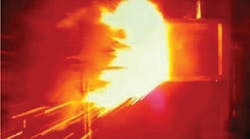Here are some tips based on post-incident reviews:
- Verify that your drawings are current.
- Don’t work on energized equipment by yourself. That so-called “quick” check or adjustment is made at the same danger level as “regular” work. You need to go through the same risk assessment and job preparation process outlined in NFPA 70E, Standard for Electrical Safety in the Workplace. You need another qualified person to review the working conditions with you.
- Never bypass devices that serve to protect people or prevent misoperation, no matter what your level of expertise or how careful you intend to be. Examples include jumpering around an interlock or propping a shutter open. If these safety devices won’t let the work proceed, then don’t proceed. Most likely, there is an abnormal condition that is causing that safety mechanism to engage.
- Whenever possible, leave covers in place. If removed, reinstall as soon as access is no longer needed. Although equipment covers don’t provide full protection by themselves, they do reduce the hazard.



